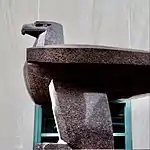
New Deal artwork is an umbrella term used to describe the creative output organized and funded by the Roosevelt administration's New Deal response to the Great Depression.[2] This work produced between 1933 and 1942[2] ranges in content and form from Dorothea Lange's photographs for the Farm Security Administration to the Coit Tower murals to the library-etiquette posters from the Federal Art Project to the architecture of the Solomon Courthouse in Nashville, Tennessee. The New Deal sought to "democratize the arts" and is credited with creating a "great body of distinguished work and fostering a national aesthetic."[3]
Background
While work of this era is sometimes called “WPA art” the architecture and the creative arts groups of the Works Progress Administration’s Federal One (Federal Art Project, Federal Writers Project, et al.) were only some of the New Deal agencies commissioning creative works. (Federal One’s budget at its height in 1935 was $27 million, representing 0.04% of GDP.)[3] The Treasury Department’s Public Works of Art Project, Section of Painting and Sculpture, and Treasury Relief Art Project, as well as the Civil Works Administration, the Public Works Administration, and the Civilian Conservation Corps[4] were also charged with creating New Deal art. Documentary photographs for the FSA as well as the Office of War Information and the Resettlement Administration are also considered New Deal art.[3] The Historic Sites Act of 1935 instigated a similar documentary record, including photographs and architectural plans, for the National Park Service properties.[5]
(Note: New Deal historiographic work is a separate, albeit overlapping, topic that includes “the Historic American Buildings Survey (HABS), the Index of American Design, the establishment of the National Archives, the historic restoration work of the Civilian Conservation Corps, the WPA’s Historical Records Survey, and the hundreds of WPA books and writings covering the histories of states, towns, folklore, art, African Americans, American Indians, Latinos, and more.”)[5]
Collectively, the artists of the New Deal produced a vast archive: Murals, including 1,100 post office murals (list),[6] free-standing and bas relief sculpture, an estimated 30,000 posters,[7] more than 700 books and pamphlets and radio scripts,[8] and architectural details for scores of public buildings, in a style now called WPA Moderne.[9]
The New Deal arts programs emphasized regionalism, social realism, class conflict, proletarian interpretations and audience participation. The unstoppable collective powers of common man, contrasted to the failure of individualism, was a favorite theme.[10][11]
Both the Whitney Museum of Art and the Museum of Modern Art created gallery shows in 1936 showcasing works by Treasury and WPA artists, respectively, that had been commissioned through the federal programs.[12] The New York Times reported that the Whitney show “abounds in vitality” and was especially complementary about the sculpture, including William Zorach’s Benjamin Franklin and Heinz Warneke’s Bears.[13]
See also
Further reading
- O'Connor Francis V. The New Deal Art Projects; an Anthology of Memoirs. Smithsonian Institution 1972.
- Kalfatovic, Martin R. (1994). The New Deal fine arts projects : a bibliography, 1933-1992. Metuchen, N.J.: Scarecrow Press. ISBN 0-8108-2749-2. OCLC 28631740.
References
- ↑ ""Copper Miner" Sculpture by R. Phillips Sanderson". University of Arizona Libraries, Special Collections. Retrieved 2022-10-02.
- 1 2 Legal Title to Art Work Produced Under the 1930s and 1940s New Deal Administration. U.S. General Services Administration. 2005.
- 1 2 3 Musher, Sharon Ann (2015). Democratic art : the New Deal's influence on American culture. Chicago. ISBN 978-0-226-24721-2. OCLC 907924703.
{{cite book}}: CS1 maint: location missing publisher (link) - ↑ Duxbury, Kathleen (2016-07-27). "The Lost Artworks of the Civilian Conservation Corps". Living New Deal. Retrieved 2022-10-02.
- 1 2 "Historic Sites Act (1935)". Living New Deal. Retrieved 2022-10-02.
- ↑ Marling, Karal Ann (1982). Wall-to-wall America : a cultural history of post-office murals in the Great Depression (3rd ed.). Minneapolis. ISBN 0-8166-1116-5. OCLC 8223038.
{{cite book}}: CS1 maint: location missing publisher (link) - ↑ Carter, Ennis (2008). Posters for the people : art of the WPA. Christopher DeNoon, Alexander M. Peltz. Philadelphia, PA: Quirk Books. ISBN 978-1-59474-292-7. OCLC 227919759.
- ↑ Writers' Program (U.S.) (1942). Catalogue, WPA Writers' Program publications, the American guide series, the American life series. September 1941. Washington: U. S. Govt. print. off.
- ↑ Maresca, Joseph (2016). WPA buildings : architecture and art of the new deal. Atglen, PA. ISBN 978-0-7643-5211-9. OCLC 946462658.
{{cite book}}: CS1 maint: location missing publisher (link) - ↑ Mathews (1975).
- ↑ William E. Leuchtenburg. The FDR Years: On Roosevelt and his Legacy (New York: Columbia University Press, 1995), p. 243.
- ↑ Richmond, Lauren, "Defining the American Vision: The Whitney Museum of American Art's Role in Changing the Landscape of American Art History" (2014). Honors Thesis Collection. 232. URL=https://repository.wellesley.edu/thesiscollection/232
- ↑ Jewell, Edward Alden (1936-10-06). "MURALS FEATURE TREASURY EXHIBIT; Works Designed for Public Buildings on View Today at Whitney Museum". The New York Times. Retrieved 2022-10-02.
